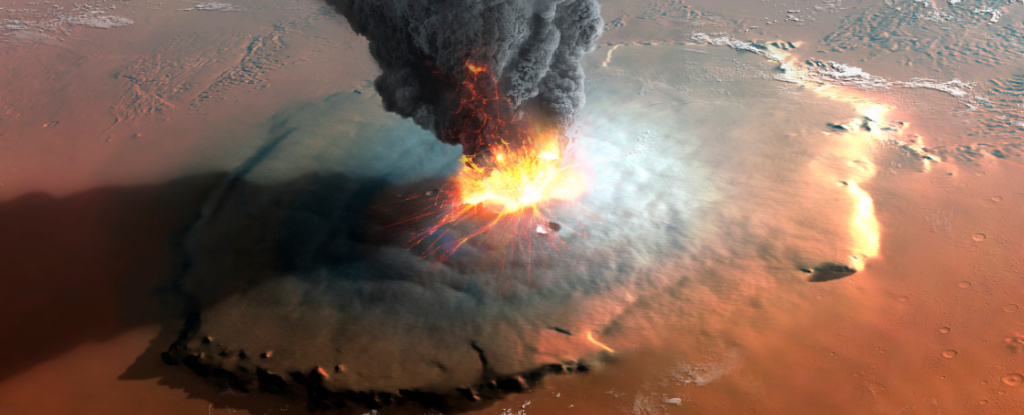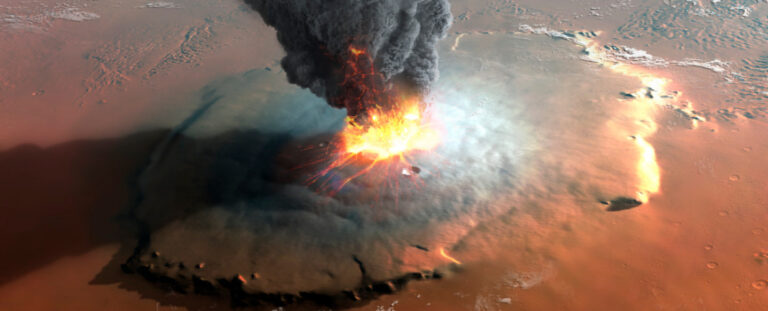Ancient Volcanoes on Mars Hold Clues to Earth’s Long-Lost Past
Mars, despite its current state as a quiet and dusty planet, has a tumultuous past that can offer insights into Earth’s own history. A recent survey of the Martian surface has revealed evidence of a volcanic landscape, reminiscent of Earth before the formation of tectonic plates billions of years ago.

Led by planetary scientist Joseph Michalski and his team from the University of Hong Kong, the study focused on the Eridania region in Mars’ southern hemisphere. They utilized data from various orbiters to identify the remnants of volcanic activity.
Unlike Earth, which has a crust made up of continental plates floating on a viscous mantle, Mars is generally considered a planet with a single plate. However, in its earlier days, Mars experienced a period of active volcanism.
These volcanoes on Mars were enormous and explosive, with Olympus Mons being the largest shield volcano, boasting a volume 100 times greater than Earth’s largest volcano, Mauna Loa in Hawaii.
The reason behind the colossal size of Mars’ volcanoes lies in the absence of tectonic plates that could release the pressure from the planet’s churning mantle. Unlike Earth, where the movement of plates constantly reshapes the surface, Mars’ crust has remained relatively unchanged. This preserved geological history could provide valuable insights into the formation of Earth’s own crust.
In their published paper, Michalski and his colleagues emphasize the significance of Mars in understanding the puzzle of planetary evolution. With approximately 70 percent of its surface being over 3 billion years old and 45 percent older than 3.6 billion years, Mars offers a unique window into the early geological conditions of the Solar System and clues about the early development of crusts.
Despite the impact craters that heavily mark Mars’ crust, the ancient geological record remains remarkably intact. This preservation makes Mars an invaluable resource for studying the conditions of the early Solar System and gaining insights into the evolution of planetary crusts.
Michalski and his team were particularly interested in the Eridania region due to its highly magnetized crust and the evidence suggesting the presence of an ancient Martian sea. By analyzing orbital data, the researchers discovered four different types of volcanoes in and around the Eridania sea: volcanic domes, stratovolcanoes, pyroclastic shields, and caldera complexes. These volcanoes were similar in structure to those found on Earth today, but with slightly larger diameters due to Mars’ lower gravity and more explosive volcanic activity.
The researchers noted that the diverse volcanism in the region was associated with unique felsic volcanic compositions not found in any other volcanic region on Mars. The topography of the ancient landscape also provided valuable insights, with the thickness of volcanic deposits, warped and folded crust sections, and sagging basins suggesting the possibility of vertical tectonics overturning the crust of early Mars.
The researchers believe that there could be hundreds more volcanoes in the Eridania region, many of which may have erupted beneath the ancient sea. This parallels Earth’s Archean period when our planet was predominantly covered in water and life first emerged. The scale of activity in this region is truly astonishing, according to study author Aster Cowart, who emphasized the opportunity to study planetary landscape evolution in greater detail by examining a Martian landscape shaped by these processes and preserved in stasis.
The study has been published in Nature Astronomy.
Do not forget to share your opinion with us to provide you with the best posts !




0 Comments